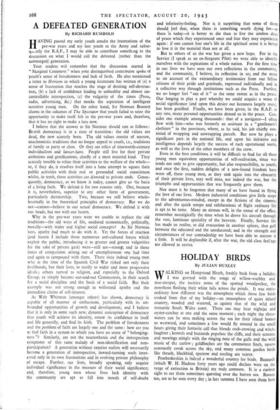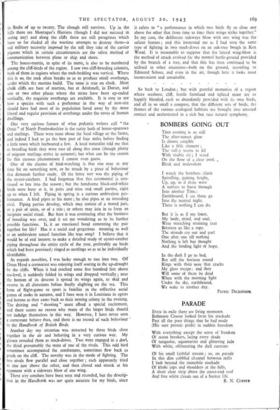HOLIDAY BIRDS
By JULIAN HUXLEY
WALKING on Hampstead Heath, freshly back from a holiday, I was greeted with the songs of willow-warbler and tree-creeper, the incisive notes of the spotted woodpecker, the moorhens flashing their white tails across the ponds. It was extra- ordinary how different was the atmosphere which those few birds evoked from that of my holiday—an atmosphere of quiet inland country, wooded and watered, as against that of the wild and romantic South Wales coast. There one may hear nightjar and oyster-catcher at one and the same moment ; each night the shear- waters can be seen making across the sea for their island homes to westward, and sometimes a few would fly around in the small hours giving their fantastic call that blends cock-crowing and witch- laughter ; kestrels and buzzards populate the cliffs, and their screams and mewings mingle with the ringing note of the gulls and the wild music of the curlew ; goldfinches are the commonest finch, ravens constantly croak across the sky, and many common garden birds like thrush, blackbird, sparrow and starling are scarce.
Pembrokeshire is indeed a wonderful country for birds. Buzzards (which W. H. Hudson forty years ago could declare were on the verge of extinction in Britain) are truly common. It is a curious sight to see them sometimes questing over the barren sea. Ravens too, are to be seen every day ; in late summer I have seen them here in flocks of up to twenty. The though still survives. Up in the hills there are Montague's Harriers (though I did not succeed in seeing any) and along the cliffs there are still peregrines which have so far eluded all the wartime attempts to destroy them—a sad military necessity imposed by the toll they take of the carrier pigeons which in certain circumstances are the safest method of communication between plane or ship and shore.
The house-martin, in spite of its name, is also to be numbered among the cliff-birds of the region. I saw two cliff-breeding colonies, both of them in regions where the rock-bedding was vertical. Where this is so, the rock often breaks so as to produce small overhangs, under which the martins build. The same is true on chalk. Most chalk cliffs are bare of martins, but at Arishmell, in Dorset, and one or two other places where the strata have been up-ended vertically, the requisite overhangs are available. It is easy to see how a species with such a preference in the way of nest-site should have had most of its population lured away by the more liberal and regular provision of overhangs under the eaves of human dwellings.
One very curious feature of what pedantic writers call " the Ornis " of North Pembrokeshire is the rarity both of house-sparrows and starlings. There were none about the local village or the farms, and indeed I had to go the best part of four miles before finding a little town which harboured a few. A local naturalist told me that as breeding birds they were rare all along this coast (though plenty of migrant starlings arrive in autumn); but what can be the reason for this curious phenomenon I cannot even guess.
One of the charms of bird-watching is that one may at any time hit on something new, or be struck by a piece of behaviour that demands further study. Of the latter sort was the piping of the oyster-catchers. I had forgotten that this ceremonial is con- tinued so late into the season ; but the handsome black-and-white birds were busy at it, in pairs and trios and small parties, right up to when I left. Piping in spring is a curious ambivalent per- formance. A bird pipes to his mate ; he also pipes at an intruding rival. Piping parties develop, which may consist of a mated pair, or a pair of units, or of a trio ; or others may join in to form an incipient social ritual. But here it was continuing after the business of breeding was over, and it set me wondering as to its further possible functions. Is it an emotional bond cementing the pair together for life? Has it a social and gregarious meaning as well as an ambivalent sexual function like true song? I believe that it would be of real interest. to make a detailed study of oyster-catcher piping throughout the entire cycle of the year, preferably on birds which had been previously ringed as nestlings so as to be individually identifiable.
As regards novelties, I was lucky enough to run into two. Off Dinas Head a cormorant was enjoying itself soaring in the up-draught by the cliffs. When it had reached some five hundred feet above sea-level, it suddenly folded its wings and dropped vertically ; near the bottom of its descent it spread its wings again, to skid and swerve in all directions before finally alighting on the sea. This form of flight-game or sport is familial in the collective aerial games of rooks in autumn, and I have seen it in Louisiana in egrets and herons as they came back to their nesting colony in the evening. The driving and " shooting " must afford .a special excitement, and there seems no reason why many of the larger birds should, not indulge themselves in this way. However, I have never seen a cormorant behave thus, and there is no record of such behaviour in the Handbook of British Birds.
Another day my attention was attracted by three birds close together in the air and behaving in a very curious way. My glasses revealed them as stock-doires. Two were engaged in a duel, the third presumably the mate of one of the rivals. This odd bird sometimes accompanied the combatants, sometimes flew back to perch on the cliff. The novelty was in the mode of fighting. The two rivals flew parallel and close together ; each apparently tried to rise just above the other, and then closed and struck at his opponent with a sideways blow of one wing.
These airy combats have been seen and recorded, but the descrip- tion in the Handbook. was not quite accurate for my birds, since
it refers to " a performance in which two birds fly so close one above the other that from time to time their wings strike together." In my case, the deliberate sideways blow with one wing was the salient feature ; and this interested me as I had seen the same type of fighting in two stock-doves on an oak-tree bough in Ken Wood. It is reasonable to suppose that the lateral wing-blow is the method of attack evolved for the normal battle-ground provided by the branch of a tree, and that this has then continued to be utilised in other situations—both on the ground, according to Edmund Selous, and even in the air, though here it looks most inconvenient and unsuitable.
. . .
So back to London ; but with grateful memories of a region where seashore, cliff, fertile farmland and upland moor are so happily blended, each so abundantly provided with its own birds, and all in so small a compass, that the different sets of birds, the themes of the various ecological habitats are brought into unusual contact and orchestrated in a rich but rare natural symphony.



























 Previous page
Previous page